Intel and Nvidia launch 11th-gen Tiger Lake H45 CPUs and RTX 3050 GPUs for gaming and high-performance laptops
Highly anticipated: Today Nvidia and Intel are making a joint hardware launch announcement that generally concerns the gaming laptop market. On the Intel side, we have new 11th-gen Core Tiger Lake H45 processors for gaming laptops and loftier performance productivity systems. Then from Nvidia, there'south new GeForce RTX 3050 and RTX 3050 Ti GPUs for laptops that pack RT features and DLSS.
These new 11th generation Core H45 processors take been long awaited equally they will finally bring Intel's Tiger Lake designs up to 8 cores, suitable for gaming and workstation class of systems and what should hopefully be more competitive with AMD's Ryzen 5000 line-up.
The new GeForce RTX 3050 Ti and the RTX 3050 laptop GPUs are interesting for a number of reasons. Only similar we saw with the RTX 3060 laptop GPU before, Nvidia is announcing the mobile part before they launch the same product on the desktop, which is something they don't do often.
Nosotros take to guess that the launch of lower-tier desktop GPUs has been impacted by insane demand for graphics cards, where there's currently no incentive to sell a cheaper product when RTX 3090s are flight off the shelves for $ane,500 a pop.
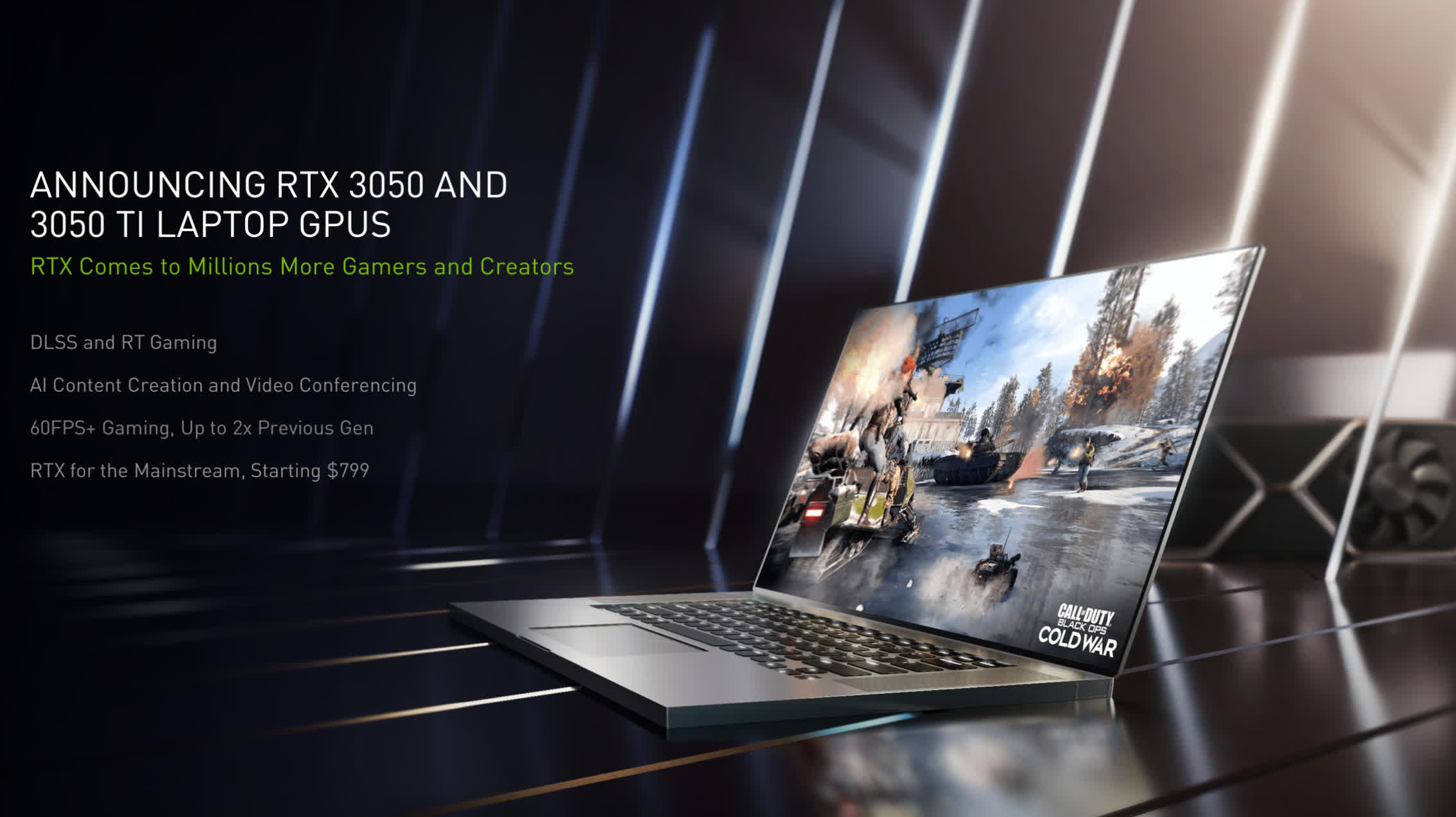
The RTX 3050 serial is based on a new GPU die from Nvidia manufactured using Samsung'south 8nm procedure, then information technology's not a cut down version of the existing GA106 being used in the RTX 3060. This is reminiscent of the Pascal era, where Nvidia's GTX 1060 variants were all GP106, then the GTX 1050 series launched using GP107. Nvidia didn't provide an official die name for this new GPU but GA107 is probable.
The RTX 3050 Ti features 2560 CUDA cores in 20 SMs, and then we see 20 RT cores and lxxx Tensor cores as a result. Meanwhile, the RTX 3050 is a cutting-downwardly variant with 2048 CUDA cores and 16 SMs, with 16 RT cores and 64 Tensor cores. Nosotros don't know if the 3050 Ti is a using a fully unlocked die, but this die does feature all the RTX features and the latest generation of encoders and PCIe technology, so this is the outset fourth dimension that Nvidia'southward mid-to-entry level die includes ray tracing acceleration.
Nvidia is giving OEMs the ability to configure these GPUs from 35 to lxxx watts, which is unfortunate equally there will exist a massive range of operation output nether the verbal aforementioned GPU name. Boost clock speeds for the 3050 Ti range from 1035 MHz to 1695 MHz, suggesting the 80W model could be up to 64% faster than the 35W model which is just insane. Similar margins are seen with the RTX 3050, 1057 MHz at 35W up to 1740 MHz at 80W.
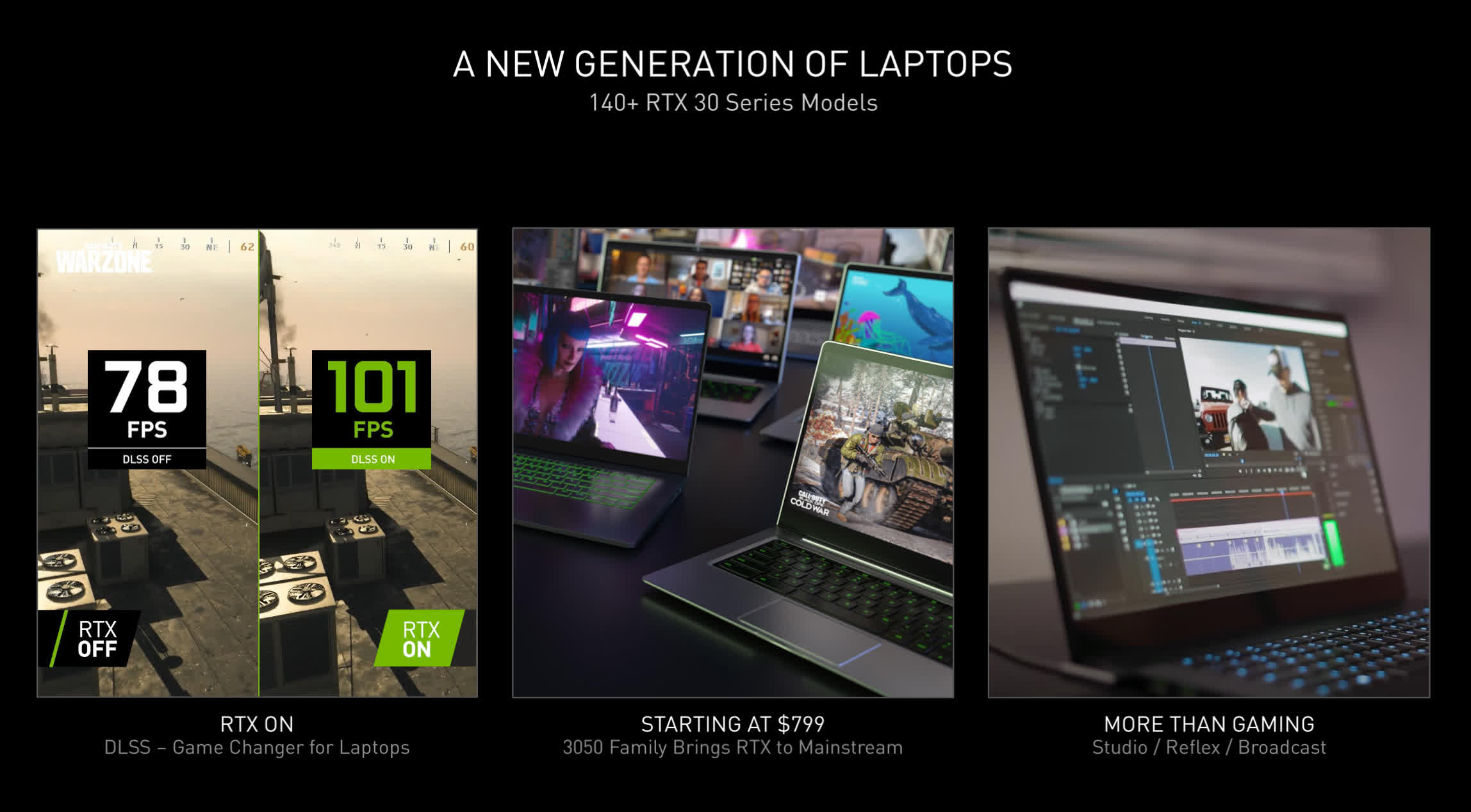
The retention subsystem used for the RTX 3050 series is identical to that of the GTX 1650 series that it'due south replacing: 4GB of GDDR6 on a 128-bit charabanc, though clock rates are currently unknown. 4 GB of memory has been used in Nvidia's 50 class equally far back every bit Pascal with the GTX 1050 in 2022, and so in that location'southward been no progress on that forepart. At the same time, with the RTX 3060 using 6GB, it would be a scrap weird for a lower-tier model to accept more VRAM.
With this sort of core configuration, 20 SMs, the RTX 3050 Ti Laptop GPU sits betwixt the GTX 1650 Ti with 16 SMs, and GTX 1660 Ti with 24 SMs in terms of layout. However, with Nvidia's new double-FP32 layout and other Ampere enhancements, we should be seeing more performance from a lower SM count than Turing just like with desktop Ampere. Similarly, the RTX 3050 has the aforementioned sixteen SMs every bit the GTX 1650 simply double the overall CUDA core count, so operation won't be double in games just volition be faster.
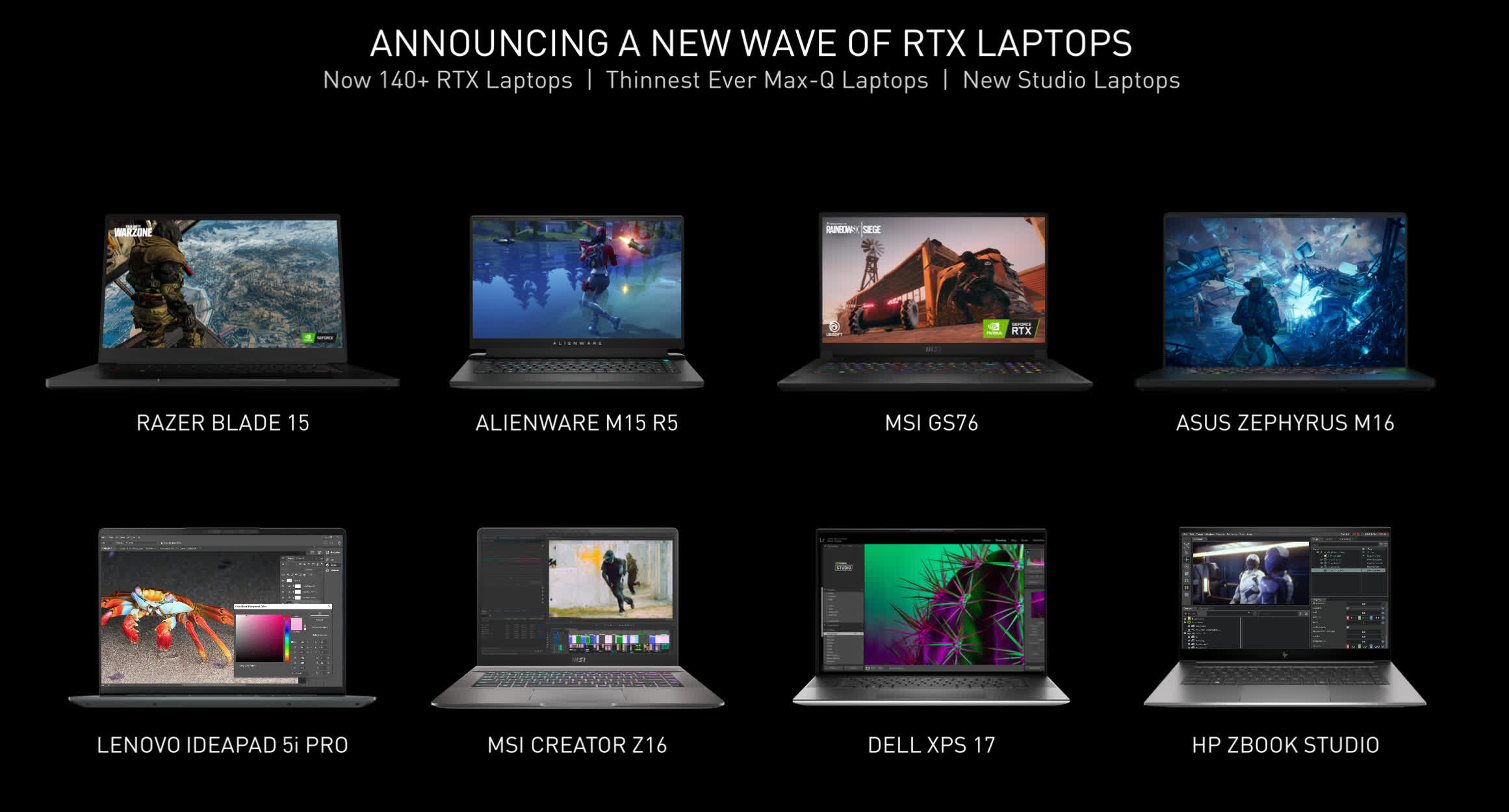
Before looking at Nvidia'due south performance claims for their mobile part, what does this mean for the desktop RTX 3050?
Based on what we've seen this generation then far, it's probable the RTX 3050 will feature a unlike SM count than either laptop GPU. Nosotros're possibly looking at 18 SMs as an example. For reference the RTX 3060 on laptops used 30 SMs versus 28 on the desktop, and the RTX 3070 Laptop GPU used 40 SMs versus 46 on the desktop.
What nosotros practice know however is that GA107's 128-bit GDDR6 memory motorcoach will restrict these GPUs to either 4GB or 8GB of memory, and let's promise for the desktop cards that effigy is 8GB. Nosotros also know that 3050-tier GPUs volition feature hardware accelerated ray tracing, unlike the previous generation where Nvidia split Turing off into the GTX 16 series without RT or Tensor cores in the lower terminate.
Nvidia'due south information nearly RTX 3050's performance was very light, instead focusing on how awesome their RTX features are, given that the RTX 3050 supports them and the GTX 1650 did not. Below you tin can see the single performance slide we got, giving u.s. a look at performance in two games without ray tracing, three with ray tracing, and all with DLSS. Nvidia tested these titles at 1080p using medium settings, DLSS Quality and medium ray tracing where applicable.
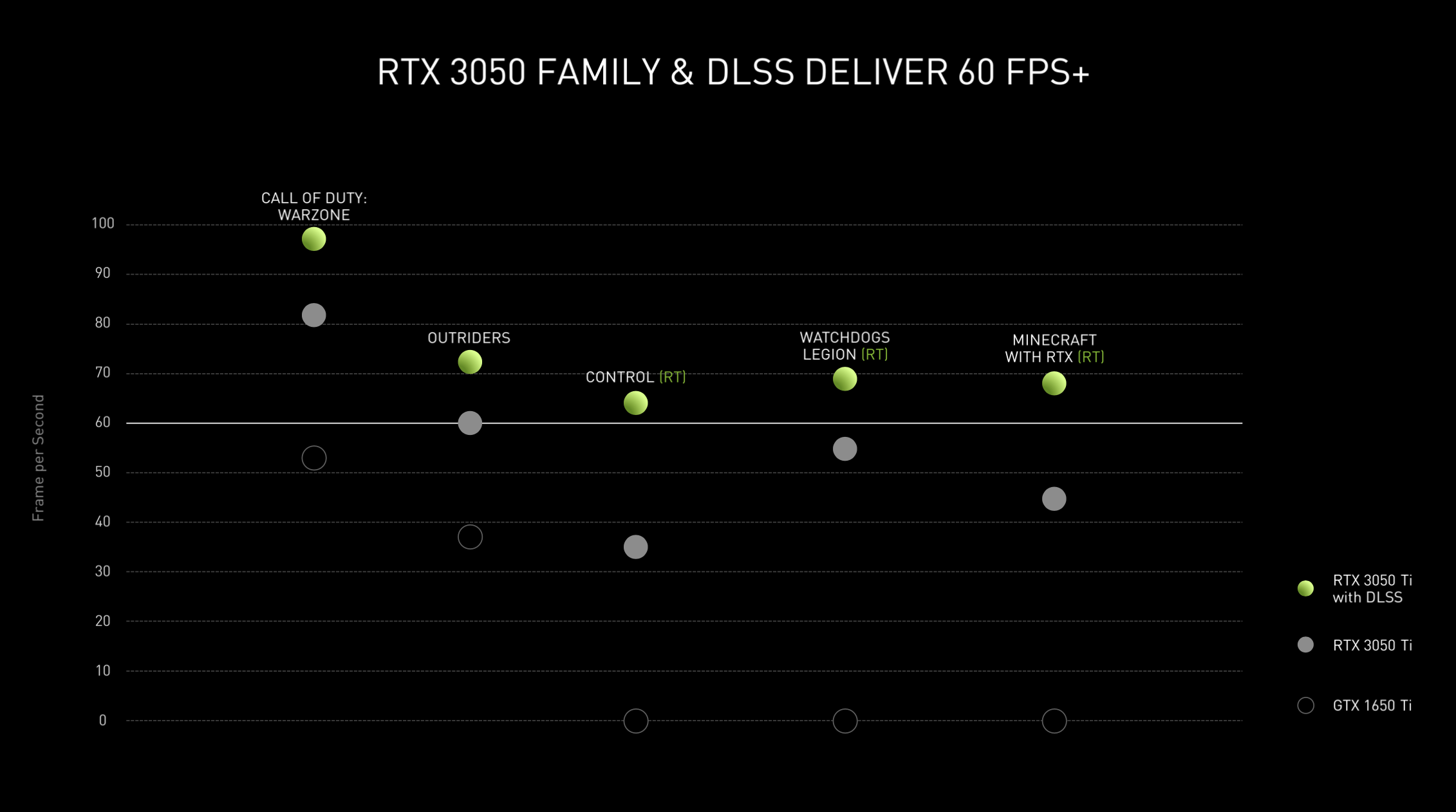
The sample size is as well low to draw whatsoever house conclusions, simply basically what Nvidia is challenge hither is that with DLSS enabled, the RTX 3050 Ti Laptop GPU is capable of 1080p medium quality gaming with ray tracing at lx FPS. That's a fairly typical upkeep laptop level of performance that you'd desire. As for comparisons betwixt the 3050 Ti and the GTX 1650 Ti, the two games shown here highlight 50 to sixty percentage better performance.
In our previous performance testing, we've seen that the GTX 1660 Ti is nigh 40 percent faster than the GTX 1650 Ti in laptops, while the RTX 2060 is about fifty% faster. We've besides seen that generally Nvidia with Ampere are giving us in their new products performance equivalent to a terminal-gen GPU from the tier higher up, so the RTX 3060 Laptop GPU is roughly on par with an RTX 2070 Super, the RTX 3070 is similar to an RTX 2080 and so on. So it would make sense that the RTX 3050 Ti falls around the performance of an RTX 2060, which is nifty for budget-class laptops. And I should stress hither that these are all mobile comparisons: Nvidia'south mobile GPUs are generally several tiers lower than what we get on the desktop in terms of performance.
Also read: Nvidia RTX 3070 Laptop vs Desktop GPU Review
Nvidia didn't provide whatsoever performance data on the RTX 3050 Laptop GPU, but if we had to approximate, it's probably shut to the GTX 1660 Ti outside of ray tracing.
The new GPUs are expected to evidence upwardly in laptops starting at $800 with designs from all the major brands. We can besides look to run across a new range of Studio-focused products that will use the RTX 3050 and RTX 3050 Ti, like the Dell XPS 15, which isn't every bit much of a gaming laptop as it is for creators.
Intel Tiger Lake H45
Intel's fully fledged H-series processors for gaming laptops and productivity beasts is finally out the door. This is the first time we're getting 8-core Tiger Lake CPUs, and the goal here is to take on AMD's impressive Ryzen Mobile 5000 series in both gaming and applications. This is also the first time we're seeing 10nm processors used outside of ultraportable low power classes, in this instance Intel's 10nm SuperFin process applied science.
From an architectural standpoint, Intel'southward 11th-gen H-series processors are similar to Tiger Lake U-series parts in many ways. The CPU cores are the same Willow Cove designs, so Intel are claiming a nineteen% IPC improvement compared to the prior generation, which in this case is Comet Lake given 10th-gen H-series didn't utilise Ice Lake and was still on 14nm using a Skylake derivative compages.
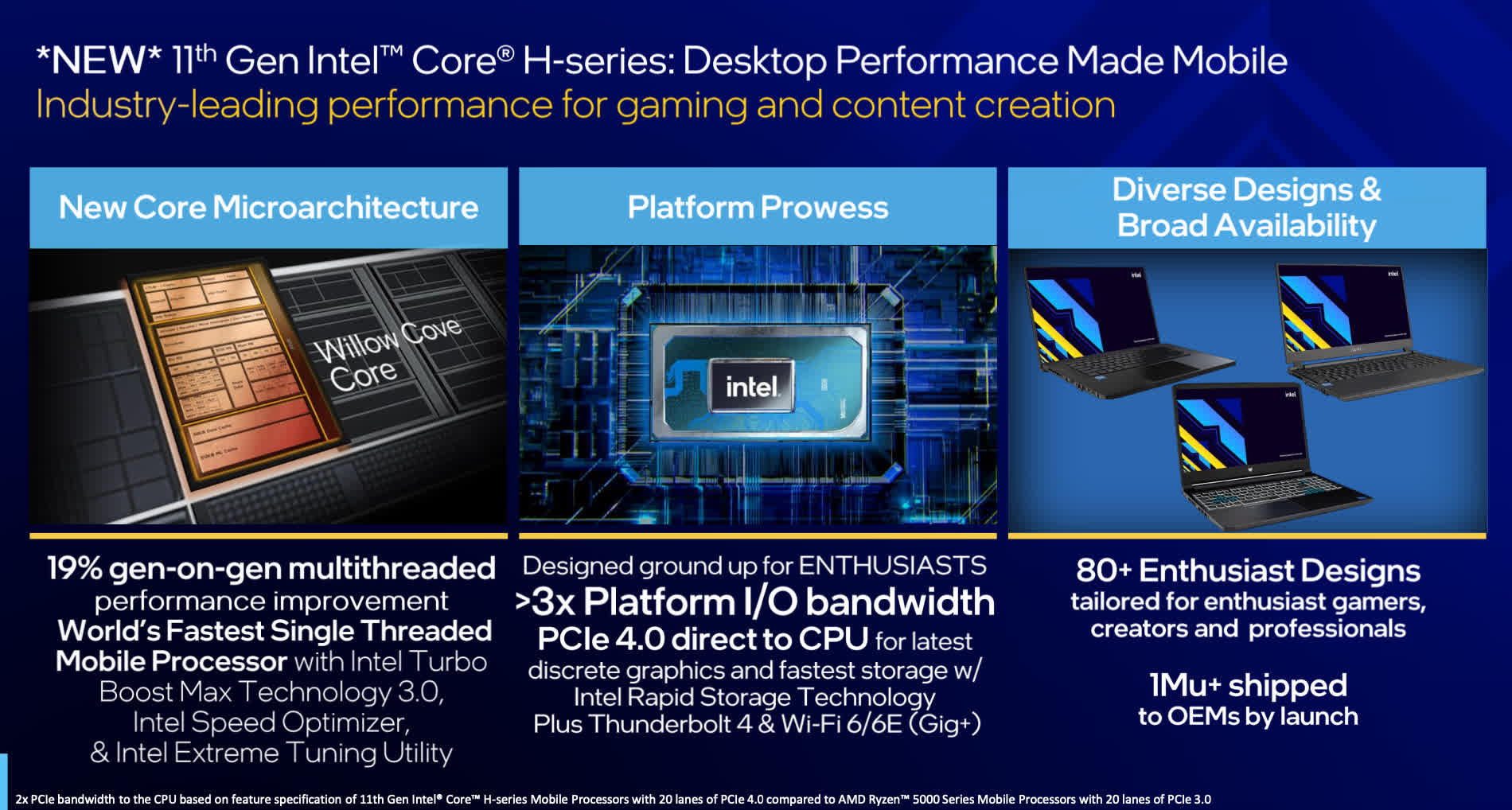
We are also seeing an upgrade to PCIe iv.0 connectivity, born Thunderbolt four support, and Intel Xe integrated graphics – all the major improvements Intel already fabricated with depression-power Tiger Lake final year.
To fit in 8 CPU cores into a reasonable size, Intel have reduced the size of the iGPU from 96 execution units downwards to 32, which makes sense every bit near H-series laptops volition include discrete graphics, making the iGPU only necessary for some hardware acceleration features.
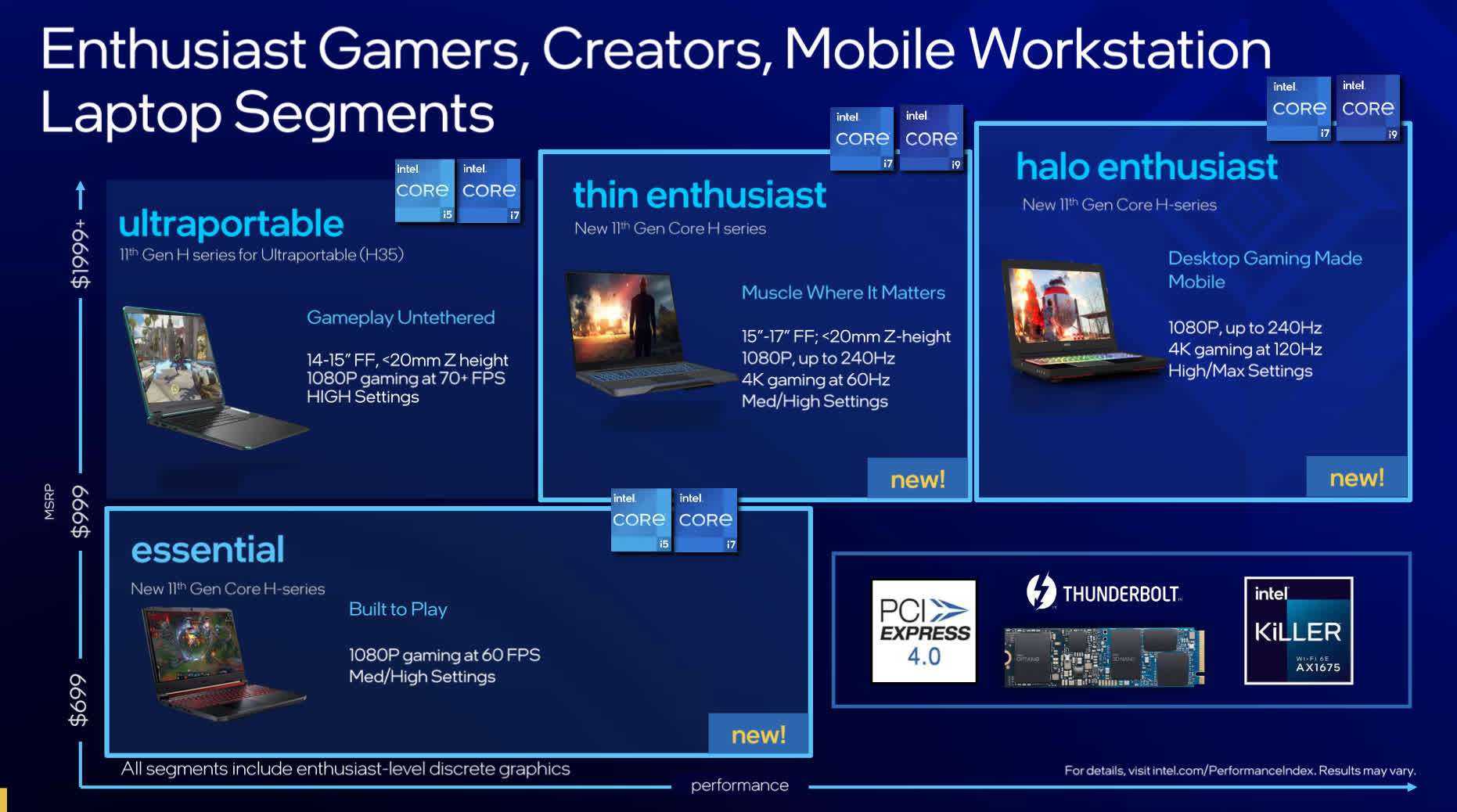
Speaking of discrete graphics, Tiger Lake H45 includes 20 PCIe iv.0 lanes direct from the CPU, enabling x16 access to detached graphics in improver to x4 direct to an M.2 SSD. The chipset included on the bundle, Intel's 500-series mobile PCH, provides additional lanes and connectivity. Like Tiger Lake U-series, the PCH is off-dice simply on the same package, which is an improvement on 10th-gen where the PCH was a split up package that also needed to be fit onto the motherboard somewhere.
AMD's approach in dissimilarity has everything integrated into the 1 dice as an APU, so there is no separate PCH. While this is a good approach from a size perspective, Ryzen Mobile 5000 uses concluding-gen technology, such every bit PCIe 3.0 instead of PCIe 4.0 that Intel are providing with Tiger Lake. In a sense, this is a significant overhaul on Intel's side of every aspect to their H-serial offerings.
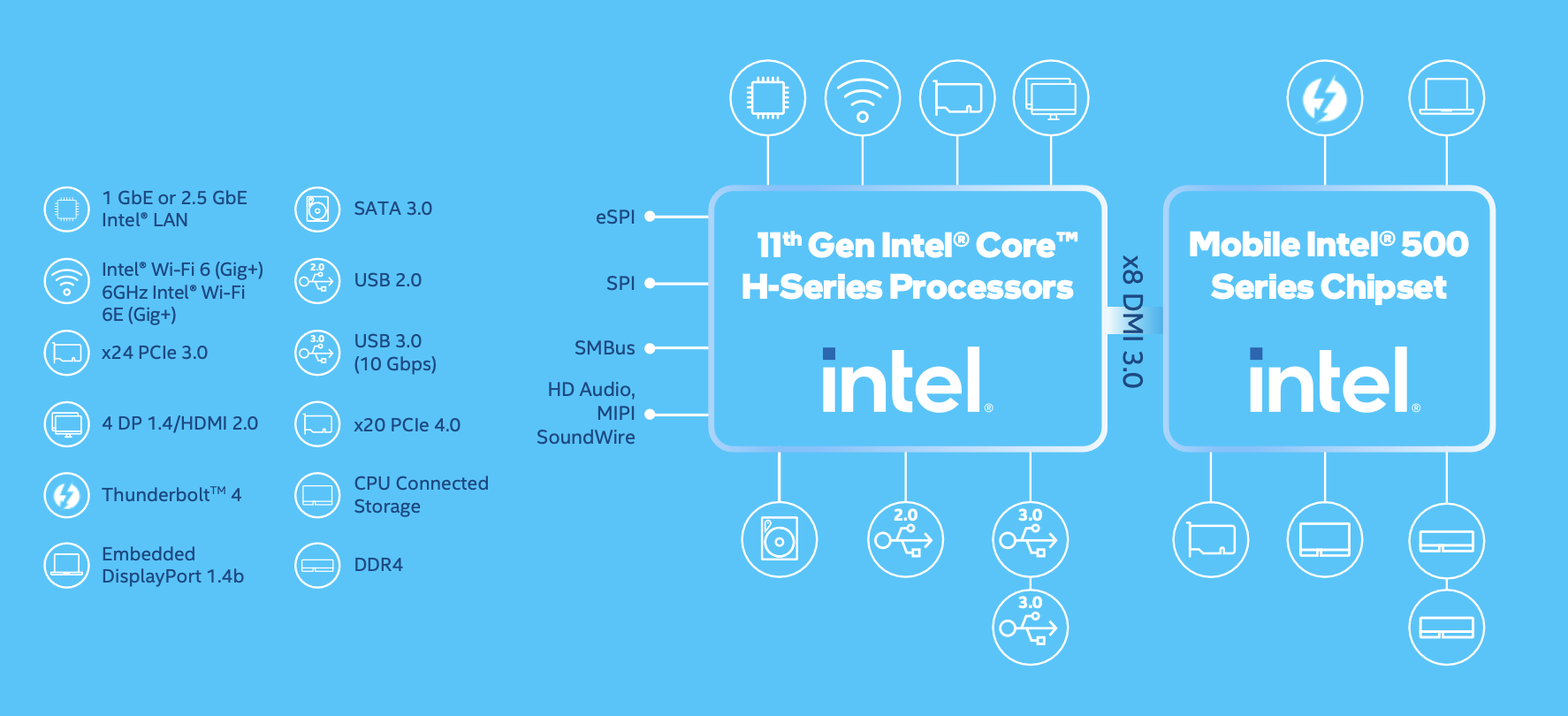
This is how the line-up stacks upwardly: 5 processors, ranging from a Core i5 up to a Cadre i9. The flagship is the Core i9-11980HK, which brings 8 cores, xvi threads and 24 MB of L3 cache. It has a base clock of ii.vi GHz and can hit 5.0 GHz on upwardly to two cores in ideal situations. You'll see some other clock speeds listed in the charts for things like all-cadre turbo, although it should be noted that virtually of these clock speeds volition only be hit briefly in burst applications before dropping down to a lower clock speed to fit within the power limits every bit set by the OEM. The 11980HK certainly won't be hitting four.v GHz indefinitely like you lot might expect from a desktop CPU.
There'south some other Core i9 part listed hither, the Core i9-11900H which is a 100 MHz lower clocked version of the 11980HK, and without the One thousand suffix, so it won't have the aforementioned fully unlocked overclocking capabilities.
And then there is a single Core i7 part, too with 8 cores and sixteen threads. It'due south lower clocked, with a ii.three GHz base and 4.6 GHz turbo, and then clock speeds on this part are 300 MHz lower than the flagship Core i9 but on the same CPU configuration.
For mainstream laptops we then have ii Cadre i5 processors, the Core i5-11400H and Cadre i5-11260H. Both are six core designs with 12 threads and 12 MB of L3 enshroud, half of higher tier products. The difference between these processors is simply 100 MHz of clock speed, with the 11400H coming in at 2.seven GHz base of operations and 4.five GHz maximum turbo.
All Tiger Lake H45 processors take a default TDP of 45W, but tin can be configured downwardly to 35W for lower ability systems, or in some cases 65W or college for beastly gaming machines. All back up DDR4-3200 as the base memory spec, and all feature the same iGPU layout and clock speeds. Intel are also providing new features in their Extreme Tuning Utility, XTU, including per core voltage controls on some models and overclocking on the 11980HK.
There are some interesting takeaways hither in terms of clock speeds: the maximum frequency Intel appears to hit on 10nm SuperFin with this Willow Cove blueprint is 5.0 GHz, downward from 5.3 GHz previously with Comet Lake. Withal Intel expects that 6% clock arrears to be nullified by college IPC, so overall functioning in lightly threaded applications should exist higher.
The base clock for the 11980HK is also higher than the 10980HK, indicating we should get the double whammy of higher operating clock speeds and higher IPC, improving performance in both regards exterior of the boost land.
With that said, clock speeds aren't always faster. The Core i5-11400H, Intel'due south new fastest six-core CPU in their Tiger Lake line, only goes upward to 4.5 GHz compared to the 5.1 GHz that was possible with the Cadre i7-10850H. That's a 12% reduction, which paired with the same 2.7 GHz base clock will brand for an interesting gen-on-gen comparison. Although I approximate it should be noted here that the 10850H was a Core i7 processor, in this new generation the Cadre i7 is an 8-core model. So comparing the exact same class of CPU, 11400H versus 10400H, we get a much needed boost from 4 cores to six cores.
Comparing the same class of CPU, 11400H versus 10400H, nosotros become a much needed boost from 4 cores to half-dozen cores.
Intel was very light on productivity performance information. They provided just three percent improvement figures for 11th-gen over 10th-gen, and the same three figures for the 11980HK versus Ryzen 9 5900HX. This tells united states of america virtually cipher until nosotros can put these to the exam.
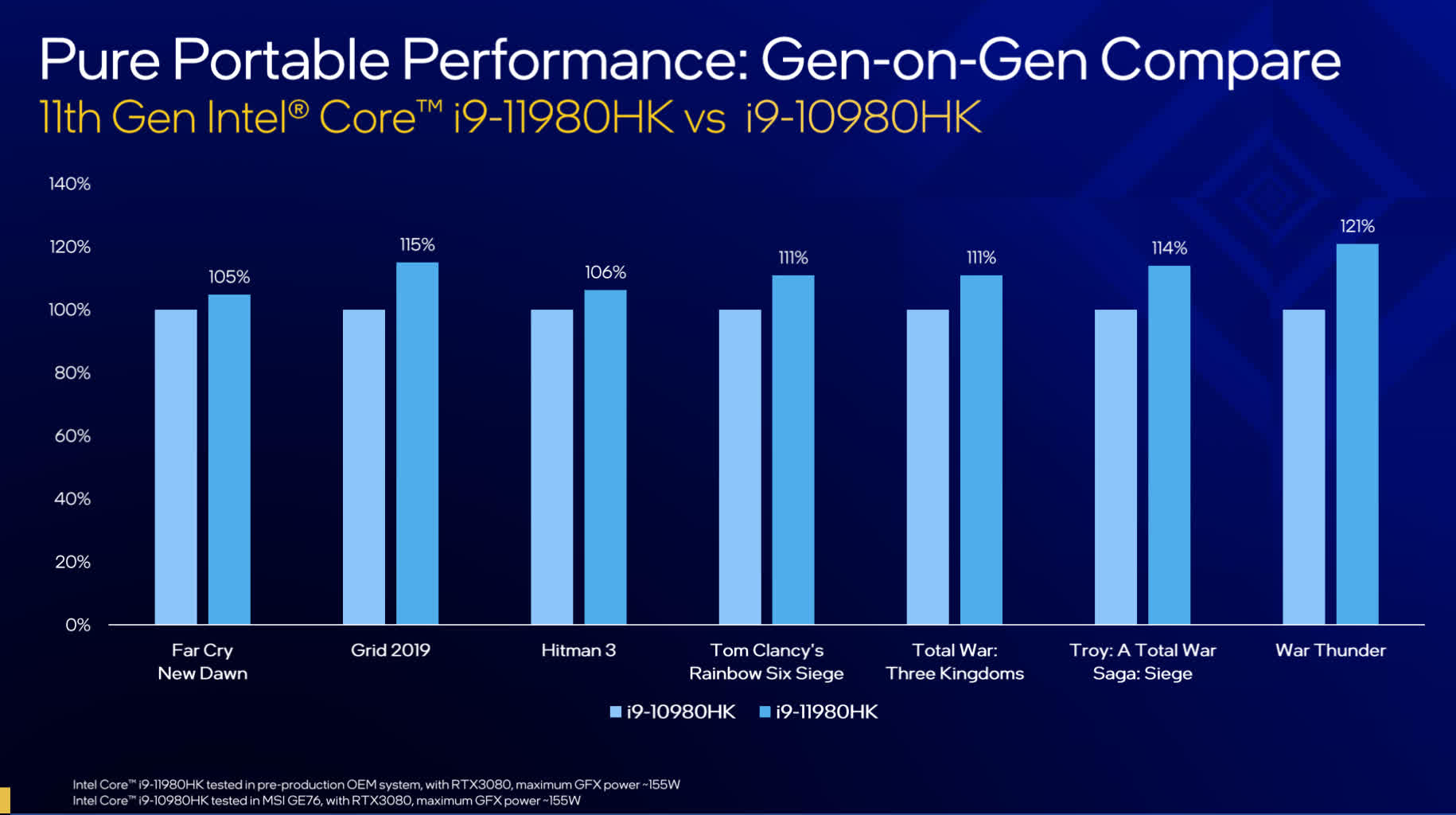
Later in the presentation, we did see a few more performance data points comparing the Core i9-11950H, which is their vPro commercial equivalent of the 11980HK, to the Core i9-10885H, another eight core CPU from the prior generation. Hither in SPEC workloads they are showing xi-12% higher single-thread performance and up to 29% faster multi-thread functioning.
If these numbers are somewhat accurate and representative of Tiger Lake's Core i9 productivity performance (remember: manufacturer provided benchmarks) -- then Intel's new Core i9 may not beat AMD's Ryzen 9 in multi-threading, while unmarried-threaded functioning may exist a close telephone call. Information technology's still a large improvement over Comet Lake, merely AMD is dominating multi-threaded performance in 45W laptops.
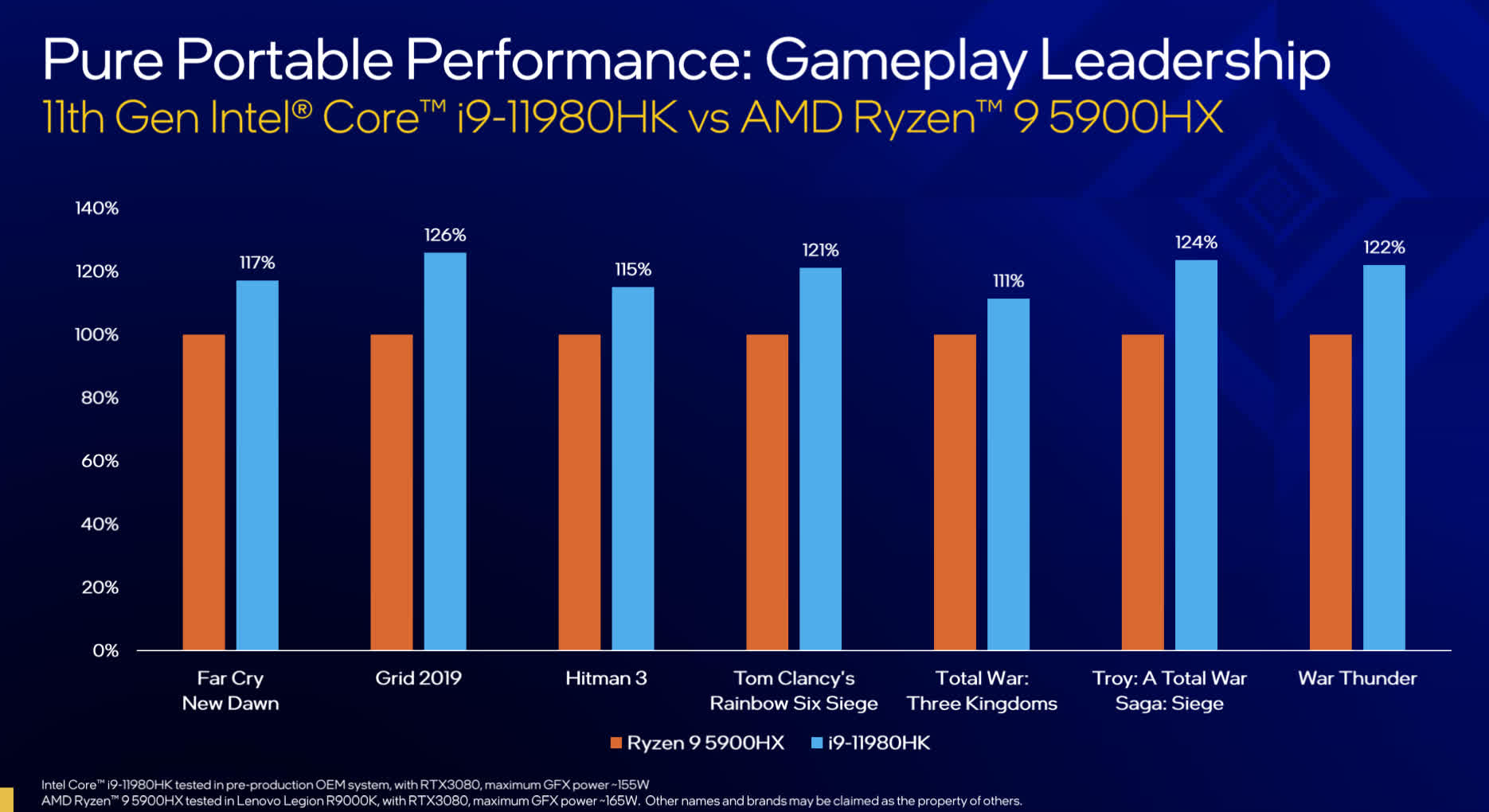
What Intel seems to be much more confident virtually is gaming performance. Intel showed performance slides comparison the 11980HK to the 10980HK in 7 titles, showing performance improvements between 6 and 21 percent when paired with an RTX 3080 Laptop GPU at up to 155W.
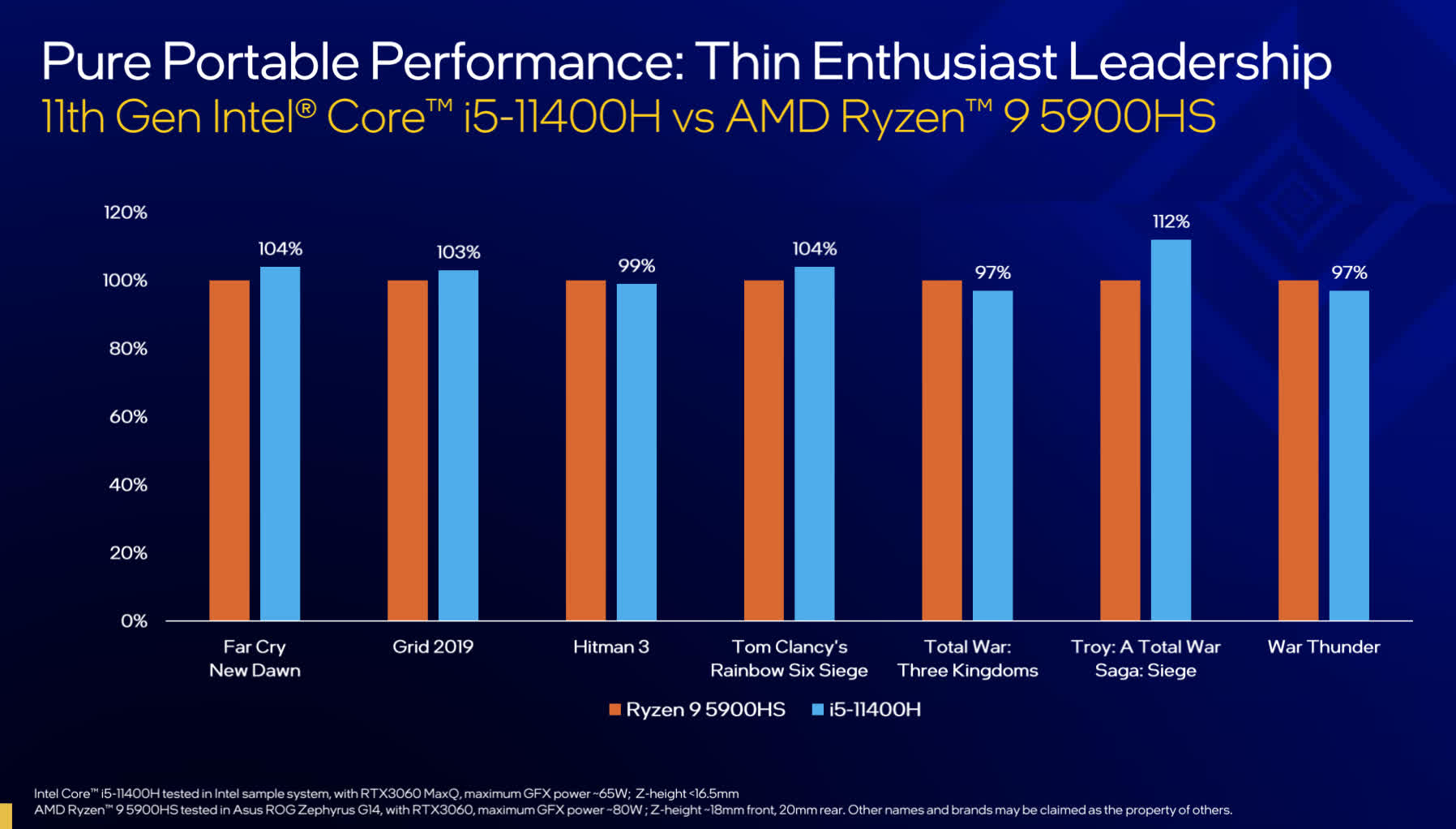
Intel also showed a slide comparing the 11980HK to the Ryzen 9 5900HX, showing a performance atomic number 82 of eleven to 26 percent with the same RTX 3080 Laptop GPU. This is a much more than informative choice of data than we got in the productivity section, and if these results are accurate, Intel volition have an impressive pb in gaming. Of grade, it will exist interesting to see how these stack upwards under independent testing where we can control all variables like power level configuration.
Intel also compared the Cadre i5-11400H against the Ryzen 9 5900HS, with the results slightly in favor of Intel using GeForce RTX 3060 graphics in a slim form gene laptop. And then that will be yet another interesting affair to explore when we get these systems in for review.
Source: https://www.techspot.com/news/89613-intel-nvidia-launch-11th-gen-tiger-lake-h45.html
Posted by: lomeliyousintor.blogspot.com


0 Response to "Intel and Nvidia launch 11th-gen Tiger Lake H45 CPUs and RTX 3050 GPUs for gaming and high-performance laptops"
Post a Comment